Race Around Rwanda Race Report
 It’s 3:30am on Sunday 2nd February 2020 and there are 60 or so cyclists milling about the reception area of the Onomo hotel in Kigali, the capital of Rwanda, drinking coffee and nibbling at pastries, some lost in their own thoughts but many others introducing themselves to evidently like-minded individuals. “Have you done anything like this before?” …“Have you visited Africa before?” …“Did you sleep?” … “Have you managed to eat breakfast?” … in my case, that’s a no, no, no, and just about.
It’s 3:30am on Sunday 2nd February 2020 and there are 60 or so cyclists milling about the reception area of the Onomo hotel in Kigali, the capital of Rwanda, drinking coffee and nibbling at pastries, some lost in their own thoughts but many others introducing themselves to evidently like-minded individuals. “Have you done anything like this before?” …“Have you visited Africa before?” …“Did you sleep?” … “Have you managed to eat breakfast?” … in my case, that’s a no, no, no, and just about.
Riders begin to gather around the start line shortly after 4:00am as others are still tinkering with their bikes. Adding a few more PSI to their tyres, attaching and reattaching bike bags, and double and triple checking contents. Comparisons are being made. “How have you managed to get all you need into that tiny seat pack?” … “What tyres are you riding?” … “Dyno-hub or powerbank?” Common questions being asked and the varying answers given become a theme during the race. We’re all here to do the same thing, but each doing it in our own way.

With 15 minutes till the off, everyone is now at the start area and there’s a final race briefing. We’re to roll out with a police outrider offering an escort through the first and neutralised 10km of our near 1000km race before switching off its flashing lights and leaving us to ride on.

We’re let on our way. Cleats click into pedals and GPS devices beep. We roll down the ramp from the hotel and immediately start climbing towards a main road. The police outrider has perhaps overestimated what the pace of an ultra-distance cycling event might be and has forged ahead as if it were a motor-paced training session. It drops back towards us and a group of us start to follow close behind. There’s some long pulls up gentle climbs and so more time to make introductions and ask the same questions. I ask Ultan, an Irish guy, where he’s based. He’s in London and hasn’t managed to get much training in. He seems confident regardless.
Any nervous energy or adrenaline-rush is subsiding and people are finding their own pace. I then realise there’s no sign of the outrider. We’re racing. This is what the months of training and preparation have been for.
Kigali is a sprawling city but as we push on the buildings are becoming less grand and greenery starts to appear between them. It’s getting light and there’s a mist hanging in the air. We ride through banana plantations and the view opens up. There’s ebb and flow in riders speed and we take the time when passing or being passed to comment on the scenery. There’s an early consensus that this is going to be a special ride.

The first of many Rwandan cyclists ride up alongside and half-wheel. They love their cycling and use their heavy singlespeed bikes to transport each other and everything else you could possibly imagine. Most only speak Kinyarwanda and conversation is limited to a muraho, a thumbs up, and a goodbye, but some speak English. Boniface tells me that he’s training to be a Velotaxi rider.
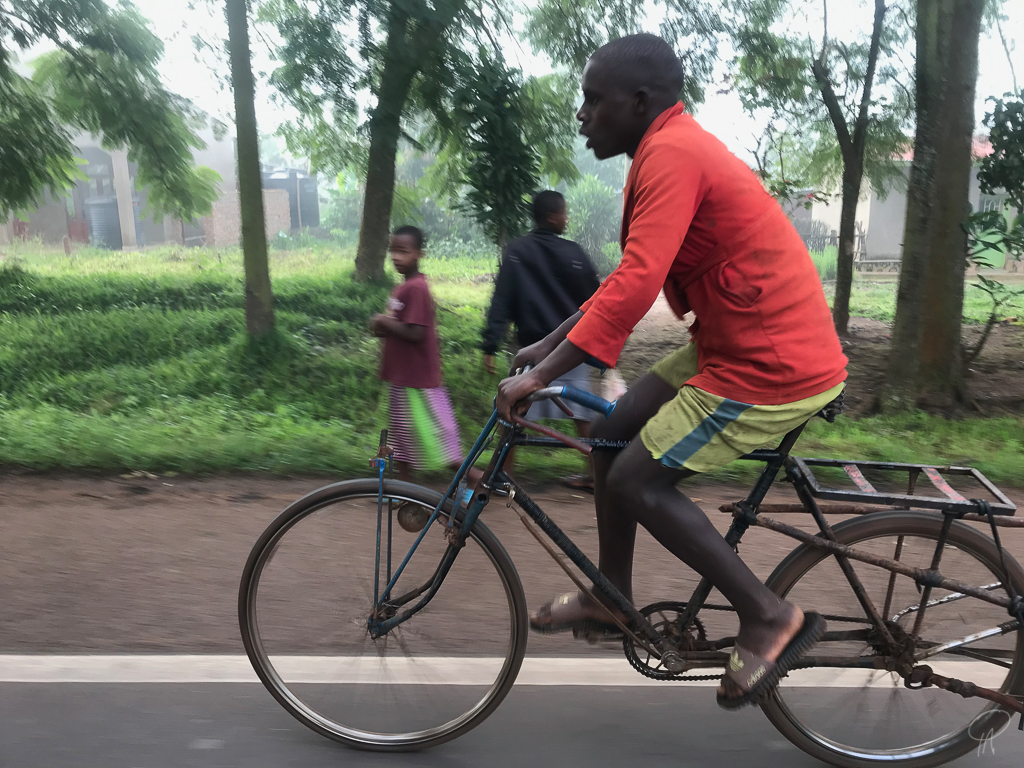

We start to ride through towns as the locals are starting their days. I’m excited to see the almost cliched sight of colourfully clothed women carrying produce on their heads. Then there’s a distraction further up the road. There’s chanting and a crowd in the road. A bunch of riders concertina as we realise it’s some kind of community run. We pick our way through the backmarkers and then the runners shout ahead and the crowd parts so that we can stream through in single file.

I’m 90 km and 3 1/2 hours in and we’ve been on tarmac so far but know that the first gravel section is drawing close. There’s a small store with a racers bike leaning outside so I follow that lead and replenish water–Amazi in Kinyarwanda–and buy a snack. A local samosa containing a boiled egg. A handful of local lads take a close look at our bikes as other riders stop which range from cheapish frankenbikes like mine through to brand new gravel bikes complete with suspension. I keep an eye on that first bike I’d spotted as its owner takes a loo break. It turns out there’s no real need to worry about security here and I hear no subsequent stories of bikes being nicked or messed with at all.
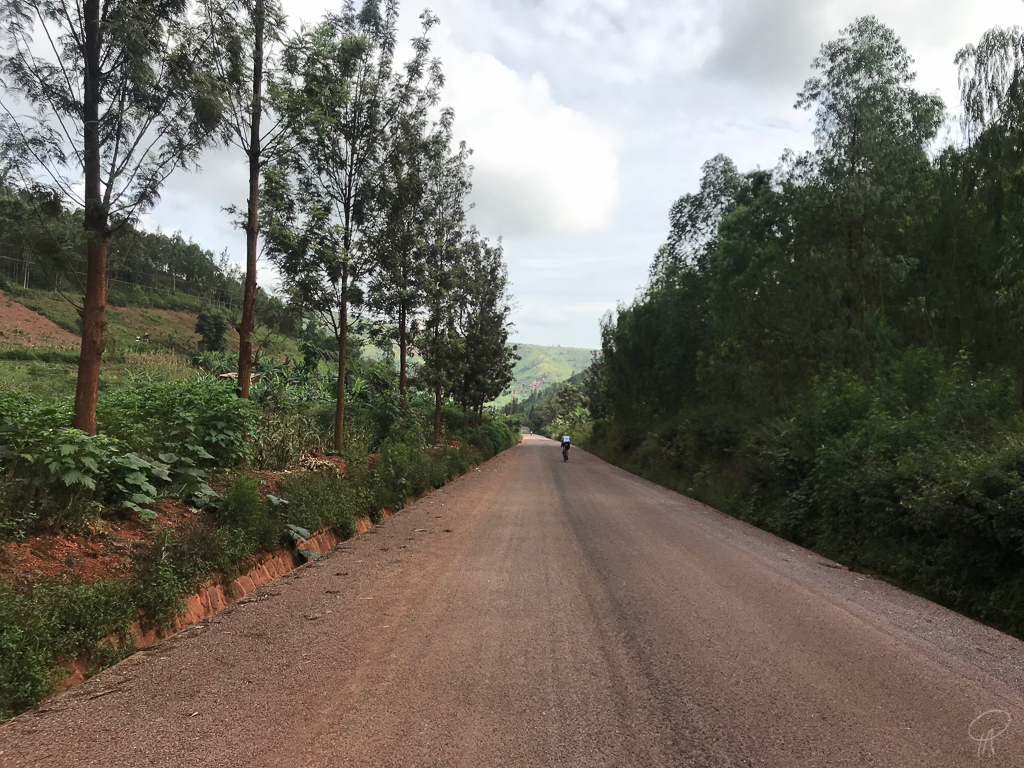

We hit the first gravel section and it’s a blast. Long sweeping downhill dry trails. Fast and fun. My tyre choice seems good. The 32mm Gravelking SKs have been rolling nicely on the road and are gripping the gravel excellently but then there’s a jarring thud and the front tyre deflates fairly quickly. I stop and the sealant is trying to do it’s thing but the hole is too big. With the help of a pair of racers, Ina and Alex, who stop get a plug in and pump it back up again. Sealant oozes out but then just about stops. I think it’ll be ok and we push on, having been joined by another rider, Eleonora. Rwanda is a densely populated country and it was rare to feel truly isolated for much of the race. We rode as a bunch for a little while. There’s a no drafting rule, but we’re riding alongside each other, picking our own lines through what has become an increasingly muddy track.
My front tyre has deflated again. This isn’t good. I pump it up and can see sealant bubbling out from a few spots around the rim. I hold the wheel parallel to the floor to try and force sealant onto the tyre bead but it’s no good. There’s less than 150km of the race done and I have to put a tube in. In taking out the valve I can see that the rim tape has folded in on itself and is no longer covering the rim bed. I resign myself to trying to spend time at the first checkpoint to sort that out.

As I stop and remove my wheel a group of local kids gathers round to see what’s going on. As with many groups of such kids one would know a few words of English—certainly more words than I knew in Kinyarwandan—and they liked to use them: “Good morning. How are you? I’m fine thank you. What is your name? My name is …”. They point at where sealant is oozing out and offer suggestions in their local tongue as to how best to fix and are intrigued as I show the pressure gauge on the pump rise and how that relates to them squeezing the tyre to check.

With a tube in I ride a little more cautiously and our loose group disperses. A bottle of water I’d stuffed into the bungees of my saddle pack breaks free and in stopping to re-attach it I find myself alone in the savannah. It’s incredible. It’s just as I imagined riding in Africa to be.

The mud is getting a bit thicker for longer sections and I catch up with a rider on a rim-braked road bike who is struggling. It’s a sticky clay-like mud which is gathering between brake callipers and frame and stopping his wheels from turning. I carry on and catch another rider with the same issue. Then another too. It’s not looking like it’s going to be a race for those who are riding road rather than gravel bikes. While the race is 80% road, the gravel sections could prove make-or-break.
The gravel gives way to tarmac again and I make my way to Checkpoint 1 in 30km or so. I’ve a bad habit of letting any regular refuelling fall by the wayside later on in a ride, banking of making up for it once I stop. With barely a kilometre to go before the checkpoint the road turned onto another gravel track and ramped up steeply. Very steeply. I pushed on the pedals but had nothing to give. I stopped and stood panting as a bunch of kids surrounded me. I caught my breath and tried again. A couple of hundred meters further on, now accompanied by the kids running alongside me, I was done. I stood with arms and head draped over the handlebars. The kids stood and stared before I inelegantly began to push my bike up the hill. Arriving at CP1 on foot was not something I’d foreseen.

The welcoming committee of volunteers at every checkpoint was amazing. They were students and being involved with the event was somehow related to their study. They threw themselves into the task at hand with a smile of their face time and time again ensuring that riders had all they need and knew what was going to happen next: I’ll get you a drink now; you’ll get some food here, and then I’ll show you the accommodation. I was handed a bottle of the first of many Skol panache drinks drunk at each checkpoint. Skol were a sponsor of the event and provided ample refreshment.
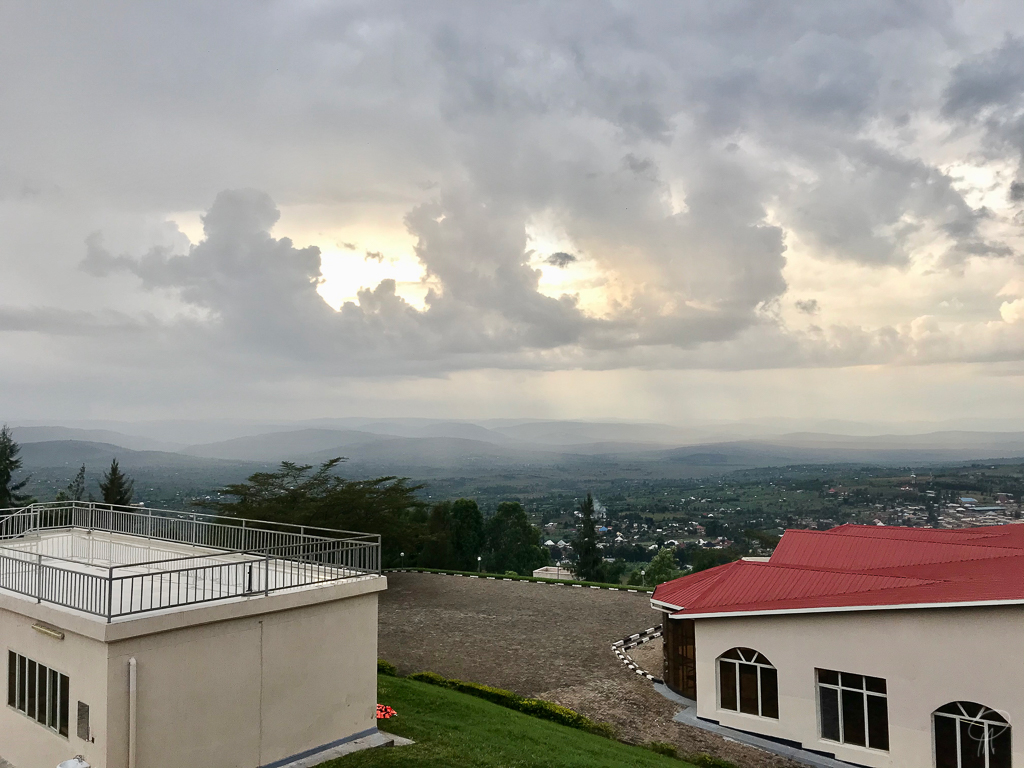
CP1 didn’t have any official lodgings provided, and I’d intended to get just a couple of hours rest and then push on. The weather forecast was for rain, and as the sun set, rain clouds could be seen in the direction we were set to travel. The next village offering accommodation was said to be 60km away. And it appeared to be 60km of uphill gravel.

This checkpoint was at some kind of event centre and they’d set the gym hall up as an ad-hoc dorm with mattresses on the floor. I felt that leaving at midnight would give me time to recover a little, refuel, and have a few hours proper rest, so having eaten two dinners I went to have a lie down. More and more riders arrived and soon the gym was full of dozing (and one snoring) riders. Shortly before midnight there was a huge roll of thunder and torrential rain started, hammering down and in places through the gym’s tin roof. I wasn’t going to head out in this and arbitrarily decided that 3am made more sense and tried to sleep some more which was tricky as claps of thunder would have everyone suddenly sat bolt upright on the floor and glancing around the room at each other in the half-light. Other than a handful of the faster riders, I think only one rider ventured out again after dark.



With things sounding calmer outside I pulled on my kit and went to grab what became a staple breakfast: boiled eggs, bananas, and capatis. Those riders that were up chatted about how we were glad that the storm had passed and wondered just who it was whose snoring had rivalled the thunder for decibels. I grabbed my bike and went to roll out but the rear tyre was nearly flat. I pumped it up and it seemed to hold so I went on my way. It was tough going. The overnight rain had made the gravel tracks soft and rutted, with some fully flooded sections and others littered with detritus washed down by the rain. Rivers seemed to be in spate and torrents of red-brown water flowed alongside the trail. The sunrise, the peace, and the landscape made up for any difficulties this brought though, perhaps not for those struggling on rim brakes mind.



After a couple of hours riding I spotted another rider up ahead. I say rider, but he was walking and pushing his bike up a long slog of a climb. I rode up alongside him and stopped. His rear mech had broken and his only gearing options were offered by his front chain rings. It had apparently broken during the first day and he’d struggled like this to CP1 and then headed out early in an attempt to get to CP2 where there was likely to be a mechanic available. I wished him the best and pushed on.

I was getting into the habit of checking food and water levels as I rolled through towns, and peering through open doorways into often anonymous looking buildings for signs of supplies for sale. I had a few key phrases half-remembered but would usually forget or mispronounce them and resort to international sign-language for wanting food or drink. Nevertheless it was fun to shop and attempt to communicate at these stops, asking “How much?” and doing some token bartering if the price seemed excessive: The going rate for 50cl bottles of water was ~30p and 1.5ltr ~60p so it seemed petty to look to drive too hard a bargain.
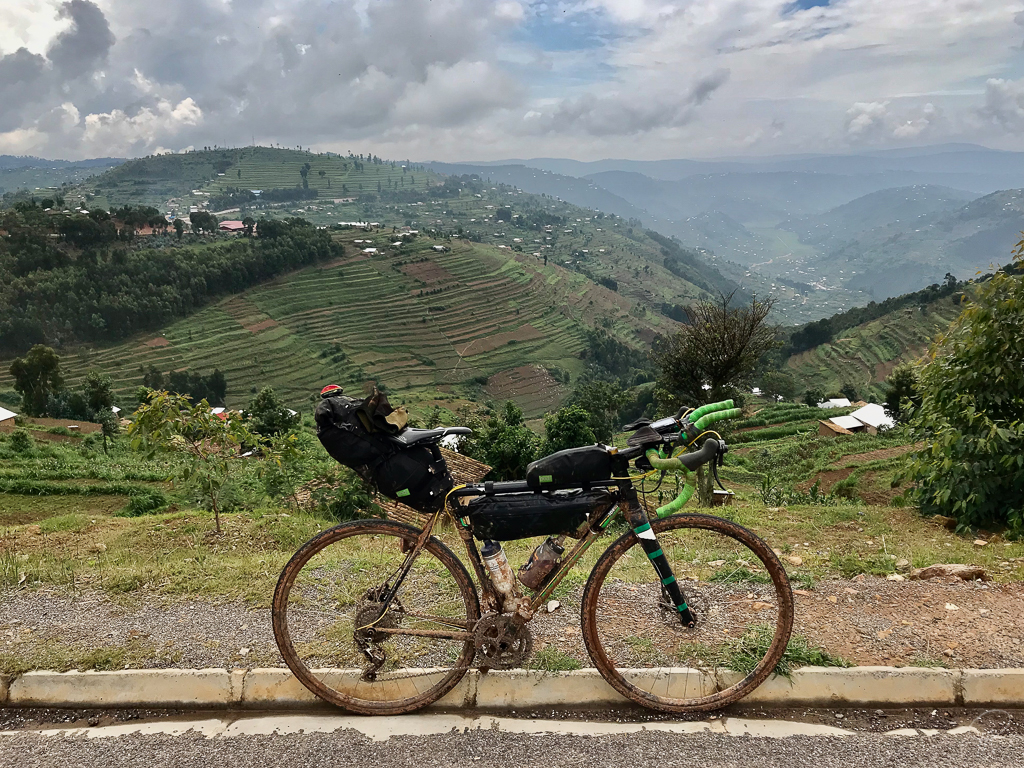


My rear tyre went down again. In pumping it up the same issue that had affected the front was occurring with sealant oozing out around the tyre bead. I pumped it back up rolled it around and hoped that the sealant would somehow cure the problem. Less than a kilometre later it was down to a worrying low pressure again and I could feel rocks bouncing off the rim. I stopped and put a tube in. This was a little scary as it was only day 2 and I’d used both my emergency tubes. I cursed those who extolled the virtues of tubeless set-ups. Tubeless is great when it works, but when it doesn’t it’s a pain.

After a fast sweeping road descent I bumped back onto another gravel track and before too long the heavens opened. The track quickly became like a river and made cycling near impossible. I pulled into the covered area at the front of a building and was immediately surrounded by maybe a dozen kids, looking at my bike and me too. After a bit of pointing at the sky and making rain gestures with my fingers, I pulled out the race handbook and used the simplified map to explain what I was doing in Rwanda. I used this trick many times again to ease awkward exchanges showing where I was going, and where I’d been.


The rain relented so I pushed on worries and savoured the landscape. I was riding towards one of the areas that had excited me the most when studying the route map. The route took a winding path up to a ridge running between two lakes and the reality was just as good as I’d hoped. There were glimpses of lakes with little islands surrounded by lush greenery and hill after hill after hill going off into the distance. Coming round each bend in the road would give another stunning vista and it was hard not to stop to photograph each one. Spending too long taking in the view rather than the trail then caught me out, I swung round a corner and clattered a rock I hadn’t seen, there was a clunk and my front tyre went down again. I stopped, ripped the tyre off and applied a patch to the tell tale snakebite-like holes of a pinch flat.

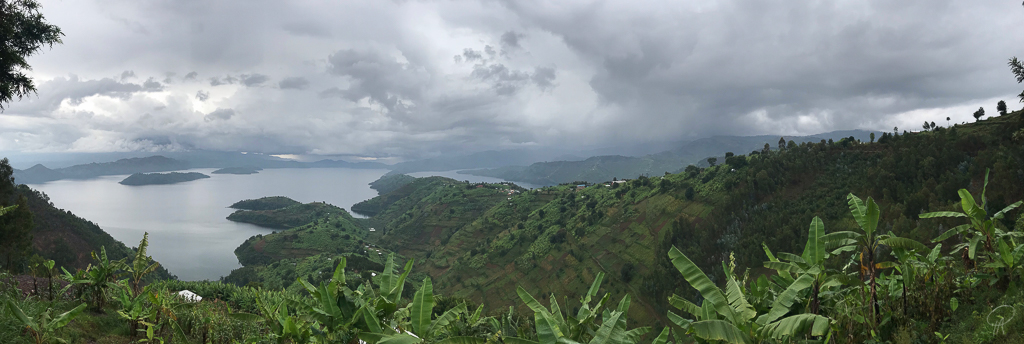
Alan and Paul, riding as a pair, caught up and checked I was ok. They rode on then shortly later stopped and I caught them up. I paused and we chatted for a little while, each proclaiming just how magical the place was, and also confirming that we’d each received a text from the organisers. The extreme weather had made a section further along the course impassible. We were to deviate from the race route and rejoin it towards CP2. The instructions seemed clear and we headed on, keeping an eye out for a path to the left towards the end of the ridge. Another pair of riders caught us up and the five of us rode within a couple of hundred meters of each other as we made our way onto back onto the road that would take us to CP2. I was feeling strong so went into ‘TT mode’ and took some nice speed towards the checkpoint until the road kicked up again and it became a bit of slog, arriving shortly before the following pairs.

Checkpoint 2 was one I’d been looking forward to visiting and it didn’t disappoint. Kiningi is the home of Team Rwanda, the national cycling teams’ headquarters and we were welcomed in and treated like pros. Our bikes were taken to be washed and given any mechanical TLC they required and we were fed and watered, and shown to our accomodation in one of the many chalet-like buildings dotted around the compound. As with the first night, my plan was to set off after as little rest as I thought I could get away with, so I got my gear in order, plugged in my phone and GPS to charge and went to load up the route for the next phase of the race. In doing this the GPS software told me that an update was required. What I’d hoped would be a quick 5 mins before bed task became over an hour of wrestling with flaky WiFi and Bluetooth syncing. I finally set my alarm for 3am and got some sleep.

It’s 3:30am and I head for breakfast. It’s only the second morning out on the route, but it’s apparent in seeing the same faces again that there’s a few of us with similar race plans: Ride between 2 checkpoints each day, but try and start those days earlier as the race goes on. We’re settling into a routine and it’s reassuring to know that we’re all doing ok. We’re nowhere close to the front of the race, but holding our own in the middle of the pack. I grab my bike from the workshop and set off up the first long climb of the day. It’s a colder morning with mist clinging to the not too distant volcanoes as it gets light. I roll through towns and other cyclists are on the road, cyclists other than the usual utility bike riders. ‘Proper’ cyclists in Lycra on relatively modern road bikes. It’s suddenly like riding at home, nodding and subtlety waving as we pass by each other.

I get another pinch flat not long after leaving the road again. The villages on the gravel track are still quiet and I patch the holes with just a single silent onlooker watching and carried on my way. I leave the gravel after about 40km and carry on along the tarmac, ‘racing’ the velotaxis and delivery bikes while having stilted conversations with their riders. My front tyre starts to lose pressure again. Just slowly so I pump it up and continue a little further up the road. I repeat this a couple of times, not wanting to go through the whole repair process again. Then it rapidly loses air. I can’t continue and roll to a halt in front of a cycle repair stand. These stands are where the velotaxis and delivery bikes get, literally at times, knocked into shape and have their punctures repaired too. I lean my bike against a wall and indicate that I’m going to fix my flat. This doesn’t translate and before I can avoid it from happening I’ve got a mechanic taking my now removed wheel from me and about to remove the tyre with levers that would be more at home on the hard shoulder of the M6. I intervene and offer a plastic lever which he finds amusing but takes and proceeds to take the tube out and looks to attach it to his pump. I’m guessing that their bikes use woods or schrader valves, but whatever they were they couldn’t use their own pump so took mine. We find the leak: It’s actually where the stick-on patches I’d been using had failed, I think getting snagged on the dodgy rim tape. They pick this patch off and then stretching the tube over the back of his hand takes a brutal looking rasp and starts to rough the tube up. I can see rubber falling away like grated Parmesan and a sense of dread comes over me, they take my traditional repair kit and apply cement then a patch and add some air. It still leaks. They add another patch. Then another. All this time a crowd surrounding us is getting bigger with advice seemingly being offered as to how best to fix the mzungu’s useless bike. One guy speaks fairly good English and elects himself director of operations, despite being clueless as to the practicalities of tube repair. Each time a patch is added he feels that not operating the pump fast enough is the cause for it not holding air. I begin to get anxious as patch after patch vanishes from my supply. They put the tube back in and then pinch it when trying to inflate. I’ve had enough and fear I’m going to have the embarrassment of scratching the race due to punctures. I take over again, insisting that I look after repairing the newly acquired hole and as calmly as I can get it patched and reinflated. I also ensure that the rim tape is as flush as I can get it, and hold it in place with a few lengths of gaffa tape. I negotiate a fee for the mechanic’s assistance, avoid paying the foreman, and roll away. I’ve still got 500+ km to go, I’m running tubes, and have little in the way of being able to repair them when they inevitably puncture again. I’m convinced my race is over or that I’ll have to return to CP2 at Kinigi to acquire spares.
Thoroughly dejected I descend into the town of Gisenyi and it’s quite a shock to the system. This lakeside town is the most developed place we’ve passed through since leaving Kigali 3 days prior. We’re to ride a lap of the bustling town before heading back out the way we came in before heading down the lake. As I turn a corner my spirits lift. I can see a couple of bike hanging from a shop front, and not the usual Rwandan utility bikes. There’s a ‘bike-shaped-object’ of a mountain bike, and a pink and white hybrid. There are a handful of teenagers with their bikes upturned outside the shop, tinkering with drivetrains and adding reflectors to their wheels. I stop and enter the shop. “Muruho”, I attempt to pronounce correctly and then “do you speak English?” The shopkeepers eyes light up as he says yes, and says he’s seen my friend ride past not long before and wanted to know where we were going. I assume my friend was another competitor and tell him that lots of my friends will be passing through before asking if he has spare tubes. He does. I could cry. They are 25s but I don’t care. They’ll work in my 32s if they have to and serve to both lift my spirits and give me the confidence to push on again.


As I’m about to leave another rider, Omar, rolls up to the shop front. We greet each other and I tell him how amazing my new LBS is. Do they have chain lube he asks. I confidently tell him they will and sure enough the shopkeeper comes out and applies some oil. I’m sure it’s not some ceramic based nano-tech lube but just as with my tubes it doesn’t matter. It’ll do the job. We’re good to go.
Our circuit of the town continues and we ride together, me dropping back a little as we encounter some pavé and his chunkier tyres cope better. I then looked up and can see him sitting on the pavement. He’s laughing as he gets to his feet when I catch him, but is stood looking down at his bike. In attempting to hop up onto the smoother pavement he’s clipped the kerb and toppled sideways onto his rear mech, snapping the hanger clean off. I check he’s ok, and fortunately he has a spare hanger, although doesn’t know how to fit it. I sort that out for him as another rider, Gavin, joins us he checks things are ok just as we realise that the newly refitted rear mech isn’t shifting. I know nothing about electronic gearing but at the back of my mind recall reading about them having a crash mode. We have to search the web on how to reset a mech, but the instructions don’t appear to work. Eventually after each giving it many an attempt we take a look and realise that we’ve not actually plugged the wiring back into the mech. That rectified we reset it again and all is good. We each start our rides towards CP3.


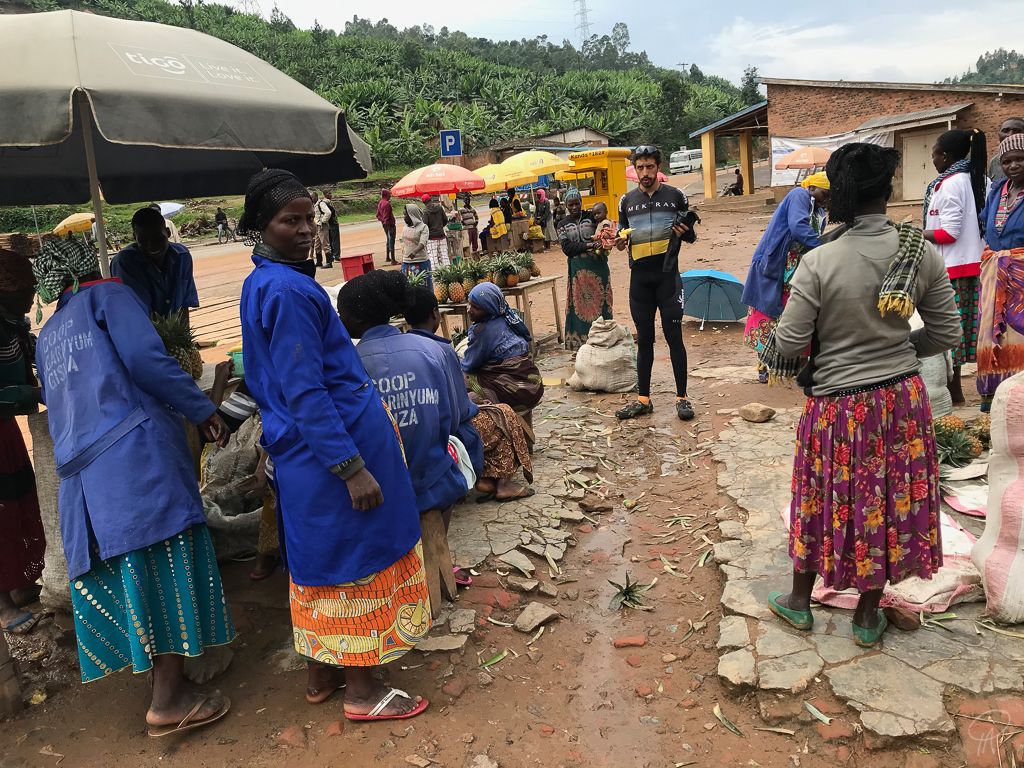

There are kids alongside the road pretty much everywhere we rode, either coming to and from school, playing, or carrying out chores. Many ask for money, which I guess is inevitable when there’s such poverty and westerners on expensive bicycles are passing by. There’s no aggressive begging, but it is a bit incessant. Gavin and I ride together into a town and stop for something to eat as Omar arrives. I drop a bank note as we enter the shop but don’t notice. I feel a tugging on my arm and a young boy is handing the money back to me. I immediately gave him a 100 Rwandan franc coin as a reward for his honesty. We each buy mango juice and a couple of pastries from a store, then a pineapple from a roadside stall. The seller takes the outer off and quarters it, offering up each slice to us on the machete-like blade. It tastes incredible.

We each push on towards the checkpoint again, riding at our respective paces through lush terraced plantations acting as the foreground to views of the lake. Checkpoint 3 was at a lakeside hotel complex and there were individual rooms on offer as accommodation. This is a chance to relax and refresh. I strip out of my cycling kit and stand in the shower. I turn the tap and there’s nothing coming out. I reach over to the basin and turn the tap there too. Again, there’s nothing. Deflated, I put my manky kit back on and head down to the reception. There was no water in the rooms until 6pm. I spent the hour until I could shower eating more food and catching up with those already arrived and following close behind me.


I hadn’t really been keeping track of distances, but getting past the halfway point was good psychologically. The one day at a time, checkpoint to checkpoint approach had naturally broken what was an inconceivable challenge to me into manageable chunks but the profile taking us from Checkpoint 3 to 4 had looked daunting from the off. This was to take us to the highest point of the route and through a rainforest to boot. In the morning as I grabbed my bike from its overnight storage place it started to rain and rain heavily. Knowing that I’d a long day ahead, and conscious that I’d already put off riding through the rain on day 2, I set off regardless riding with Omar who was the only rider around as I’d had breakfast earlier on. After 40 minutes or so the rain abated and the climbing started. We made a casual arrangement to perhaps see each other at a hotel for food a few hours into that stage and settled into our own rhythms. The scenery was spectacular and the roads alpine-like with huge sweeping bends sitting on terraces cut into the hillsides.



I was feeling good for 3 long days of riding but hadn’t been great at eating proper food during the days, so the suggestion of somewhere to stop was appreciated. Sure enough and as promised I spotted a hotel as I rolled through the town of Nyamasheke and pulled through the bright white archway into a courtyard and saw a sign for the restaurant. The restaurant itself wasn’t quite as smart as the exterior but I ordered a plate of all they offered, a plantain stew. The plate was put in front of me and it wasn’t quite as expected. As well as the plantain there was an awful lot of offal in there: stomach and intestines. I know that this is good wholesome food, but I just couldn’t face it mid-race so I picked at the plantain, apologetically indicated that I was full and left still somewhat hungry and with the climb proper still to ride.


The climb was long and it was hot, perhaps the hottest it had been on the ride so far. The scenery was changing and as the road got higher it passed through vast tea plantations with workers gathering leaves.

From the tea plantations things changed quickly again, passing under an arch welcoming you to the Nyungwe Forest national park you were quite suddenly in the rainforest. The rainforest straddles the border with DRC and the road is patrolled by the Rwandan army. Every kilometre or so there is a soldier or two. Despite this, it’s easy to feel like the only human in the forest. The whistles, buzzes, and screeches coming from birds and insects was incessant. The terrain and the scale of the plants and trees make to surround you walls of greenery hundreds of meters high, and where there were gaps they were filled with views of forested hills and valleys as far as you could see. Occasionally small groups of, I think, L’Hoest monkeys would appear by the roadside, disappearing into the dense forest when approached.

This had been one of the longest stretches without any village to replenish supplies and I was running short on water so was relieved to reach a visitor centre as the climb began to plateau out. Pulling up I was pleased to see a number of bikes lined up and even more pleased to see some riders wearing Race Around Rwanda jerseys sat at a table. They were a bunch of 9 from London undertaking ‘the journey’, a non competitive version of the race picking and choosing where to ride, and immediately offered me some crisps and water. They then mentioned that they’d somehow ordered a lunch too many and asked if I wanted a spaghetti bolognese. After the earlier offal ordeal, this was just what I needed. We chatted for what was the longest mid-ride stop I had in riding all week. I was even given a wider inner tube as a better back-up for the ones I’d bought in Gisenyi as I went on my way.

The plateau turned out to be anything but flat, but fuelled up I made good progress through the remainder of the forest. The forest stopped almost as soon as it had begun, and I found myself descending towards checkpoint 4 along wide but quiet roads through smaller towns and villages. I was joined by another rider, Chris, as it started to rain again. He was riding as a pair but more confident descending in the rain than his partner so had pulled ahead. It rained quite heavily right the way till checkpoint 4 in the town of Huye. The larger towns visited on route were quite a contrast to the many smaller towns and villages and Huye was no exception with us having to weave in and out of quite heavy traffic. Huye did though, have some very impressive looking segregated cycle lanes too. Just like the UK they weren’t always used, in this case they were cobbled making for a far rougher ride than the road alternative.

I woke at the final checkpoint knowing that I was going to make it to the finish line back in Kigali. Only 175km remained and there was plenty of time before any cut off might affect my chances. It had rained again, and being at a slight altitude made for a chilly morning. I rode with leg warmers for the first time in the race which acted to serve to block the sun from my rather sunburned legs once the sun did break through after a couple of hours riding. I hit the final gravel section of the ride. 65km or so of undulating tracks through towns and villages where just as had happened each day kids would call out Mzungu! and then run to the side of the track to wave, offer a hand to be high-fived. There was still some cries for money, but many more just going through the ‘good morning, how are you?’ rote ritual. I’m not actually sure anyone knows how to respond with anything but ‘fine, how are you’ but hey …
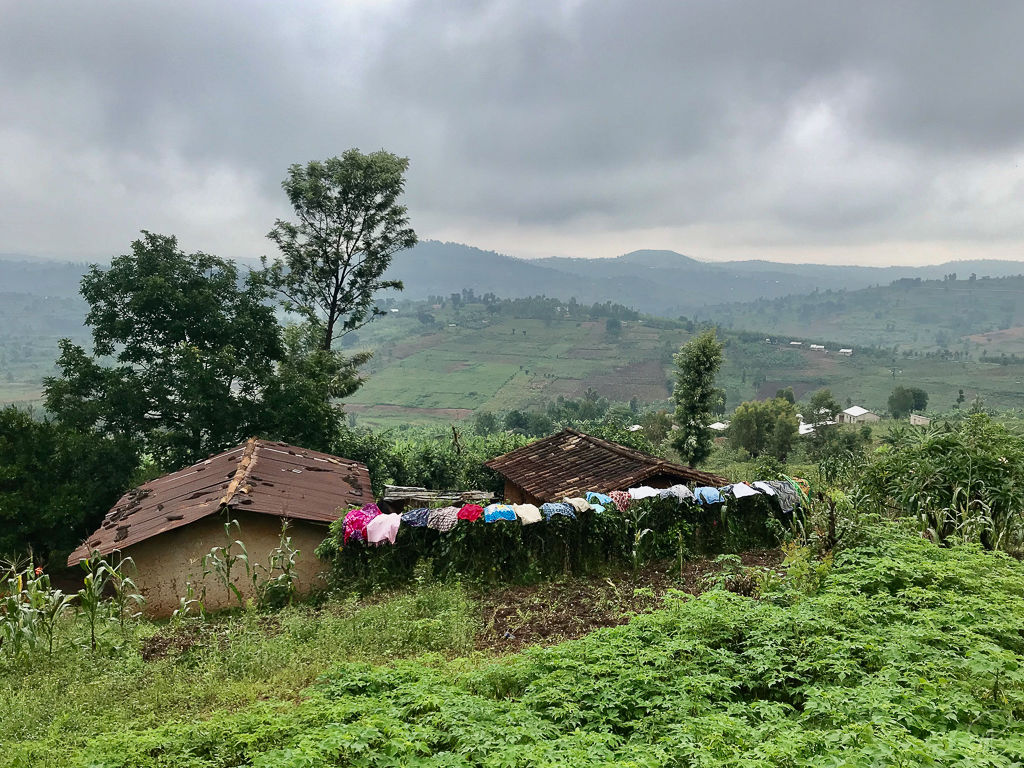
A few kilometres along the track and descending another hill a kid was dragging his bike up in the opposite direction. I stopped to say muruho and take a closer look. His bike was amazing. Made entirely from wood, including the wheels, it had similar front-end geometry to a downhill mountain bike. I asked if I could take his picture and he proudly stood by it. I then indicated that we should race and he swung the bike round and shot off down the hill. He’d covered a fair distance before I caught him up, congratulating him on his win and headed on drawing closer and closer towards Kigali.

The track was still muddy in places as a result of the overnight rain. I climbed around a switchback and ground to a halt as thick clay-like mud clogged between tyre and forks. A bunch of kids came running across from their home with sticks and proceeded to scrape the mud away. I thanked them and pushed on. Within a meter it was clogged again. There was nothing else I could do but shoulder the bike for this stretch. 5-600 hundred meters later and the track was dry enough to ride again.


With it being overcast I hadn’t put my glasses on when it got light and caught a fly full on in my left eye. I tried to fish it out but couldn’t. I tried blinking but it just wouldn’t shift and my eye was streaming. A local woman stopped and I mimed a fly buzzing along and pointed to my eye. She made a pinching motion and pointed too. I smiled and said kunezeza, please. She took the bundle of sticks down from the top of her head as I passed her a wad of tissue from my frame bag. She rolled it into a point and I held my eye open. A couple of seconds later the fly was plucked out, and I was good to go again: medical assistance received without a common word of understanding. I pulled my glasses from my helmet and put them on.

The landscape was changing. We were back to savannah and villages became further apart. For one of the few occasions during the ride I felt alone again, which gave me time to reflect on what I’d achieved. I may have cried a little. What had gone from a vague mention of a race in Africa had turned into me #JFDIing it, signing up and booking flights, and undertaking a pretty intense training plan with the aim of completing my first ultra-distance event. I was never going to be at the sharp end of the race (the winner had finished almost 2 days prior) but getting to the finish was now within sight.
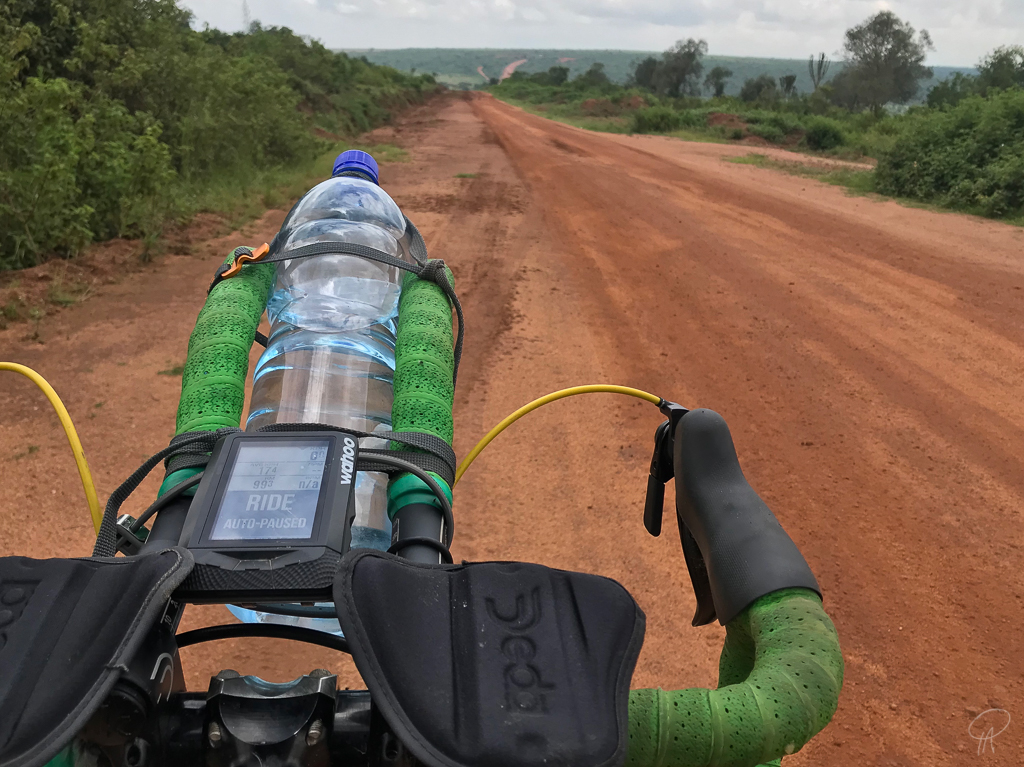
I dropped out onto the road knowing there was 55km to go. I stopped to fill bottles one more time, put my head down and rode hard. There were kilometre markers counting down the distance to Kigali and I ticked them off as I passed. The sides of the road were becoming more built up and I reached the outskirts of Kigali. I knew from the elevation profile that there was one final kick before a mainly downhill finish. That kick was hard work: almost 10km up an under-construction, but in-use anyway dual carriageway. I dug deep and pushed on only to feel my front tyre go flat. The heavily patched tube from 500+ km ago had met its match. I stopped and replaced it with the one given to me in the rainforest.
I rolled into the finish after 4 days 11 hours and 13 minutes, welcomed by a small group of race crew and other racers. For what it’s worth a top 10 finish. Job done. Over the next hours and days I caught up with riders I’d seen en route. Some I’d briefly at the start or within the first neutralised 10km and others I’d seen near every checkpoint. Everyone had a tale to tell. We’d each entered the same race yet each completed such a different one.


I’ll update this page shortly I’ve added blog posts with details of my bike set up and kit. I found it useful to look at what others have done in the past when researching my first ultra-distance race and my experience may prove useful to others.
There’s more details about the race at racearoundrwanda.com. If you’ve questions about taking part in a future edition, I’m happy to offer advice. Get in touch via pete@hypertelia.com or @peteaylward on Twitter.
Finally, thank you to Matt and Simon for putting on the event, and to the sponsors and volunteers for making it happen. #RideOn